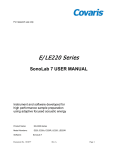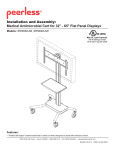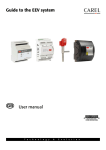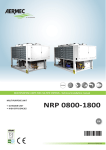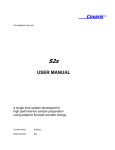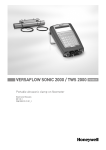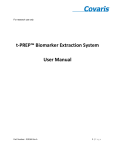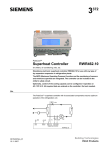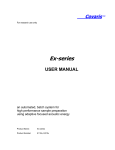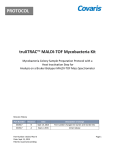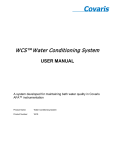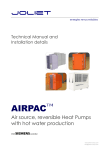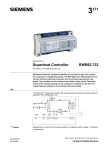Download S220 Series USER MANUAL
Transcript
For research use only S220 Series USER MANUAL Instrument and software developed for high performance sample preparation using adaptive focused acoustic energy Product Name: S220-Series Model Numbers: S220, S220x, S220R Software: SonoLab 7.2 UNIVERSAL PRECAUTIONS Universal Precautions should be followed on all specimen samples, regardless of whether a sample is known to contain an infectious agent. Laboratories handling specimen samples are advised to comply with applicable parts of the following governmental and clinical standards, or their equivalent in the country of use: Centers for Disease Control (CDC), Universal Precautions for Prevention of Transmission of HIV and Other Bloodborne Infections, published 1987, updated 1996 Clinical and Laboratory Standards Institute (CLSI), GP17-A2 Clinical Laboratory Safety; Approved Guideline Second Edition, published 2004, ISBN 1-56238-530-5 Clinical and Laboratory Standards Institute (CLSI), M29-A3 Protection of Laboratory Workers from Occupationally Acquired Infections; Approved Guideline, Third Edition, published 2005, ISBN 1-56238-5674 Occupational Safety and Health Administration (OSHA), 29 CFR 1910.1030 Bloodborne Pathogens International Standards Organization (ISO) 15190:2003, Medical Laboratories – Requirements for Safety Trademarks Patented or patent pending and registered or registration-pending trademarks of Covaris are protected. Registered names and trademarks used in this document, even when not specifically marked as such, are not to be considered unprotected by law. WCS and AFA are either registered trademarks or trademarks of Covaris, Inc. in the United States and/or other countries. Clorox is a registered trademark of The Clorox Company. Teflon is a registered trademark of The DuPont Company. Information subject to change without notice For Research Use Only Not for use in diagnostic procedures Publication P/N 010122 Revision F, May 2014 Product covered by Patent No. US6, 719,449, US6, 948,843, and other pending applications Copyright © 2014 Covaris, all rights reserved. Covaris, Inc. 14 Gill St, Unit H Woburn, Massachusetts 01801-1721 USA S220(x) User Manual Printed in U.S.A. Page 2 Warnings For safety of operating personnel: Make sure that the equipment is properly grounded. DO NOT operate if it is not properly grounded. The unit is equipped with a power plug appropriate for the destination country. DO NOT, under any circumstances, remove the grounding prong from the power cord. Do not run an acoustic treatment with the Acoustic Assembly and sample cover in the UP position or without a water bath - the acoustic system will not work. If there is any indication that the Safety System is not functioning properly, DO NOT operate the equipment and contact Covaris immediately. If the equipment is used in a manner not specified by the manufacturer, the protection provided by the equipment may be impaired. To prevent damage to the equipment: The instruments are designed to operate in ambient laboratory conditions e.g., 15 to 32C (60 to 90F). DO NOT operate the instrument in a cold room environment; the system is designed to operate with a water bath and recirculating heater/chiller apparatus to control sample temperature. NEVER run a method without a water bath; this could damage the transducer. The instrument is equipped with a water level sensor to protect the transducer and degassing pump. The system will not allow the degassing pump to operate or the acoustic treatment to start unless an adequate volume of water is detected. Distilled or deionized water should be used to fill the water bath. Unless a Water Conditioning System (WCS) is employed, empty the water bath and wipe it dry EVERY day with a lint-free cloth. DO NOT leave water in the tank for an extended time as there is no water filtration or water cleaning system within the apparatus (unless WCS is employed). Do not employ isopropyl alcohol, ammonia-based or abrasive cleaners on the water tank, as these will damage the acrylic surfaces. Establish a standard of operation and periodically test equipment, as described in Maintenance (see section 6.0) of this manual. Loading third party software onto the computer may interfere with system operation. Please consult with Covaris. S220(x) User Manual Page 3 Warranty When used in accordance with written instruction and under normal operating conditions, the Covaris instruments are guaranteed to be free of defects in MATERIAL and WORKMANSHIP for one (1) year from the date of original delivery by an authorized representative. Any component which proves defective during the stated period will be repaired free of charge or replaced at the sole discretion of Covaris, F.O.B., Woburn, Massachusetts, U.S.A. provided the defective component is returned properly packaged with all transportation charges prepaid. The customer is expected to perform basic diagnostics and component replacement with telephone support from Covaris personnel. If Covaris personnel are required to perform on-site repair, all travel related costs are paid by the customer. A limited warranty as specified may apply to certain components of the equipment. Warranty Exceptions This warranty is void if failure of the software or hardware has resulted from accidents, abuse, improper maintenance, or repair, or misapplication by the customer. It is also void if damage is caused by any unauthorized attachments or if modifications are made to the equipment. Removing or tampering with the Safety Enclosure will void the warranty, and the customer will assume all liabilities. This warranty is limited to the original purchaser and is not transferable. The software will perform according to the accompanying written materials and the medium on which the software is delivered is free of defects in materials under normal use and service. The warranty is void if damage has resulted from third party software not intended for use with the system. The high power focused transducer is designed to give maximal mechanical energy output in water. Permanent damage to the transducer and electronic circuits could result if the transducer is operated without water. Operation of the system without water in the water bath voids the warranty. CONTACT COVARIS, INC. SHOULD YOU HAVE ANY QUESTIONS CONCERNING EQUIPMENT Warranty Services The purchased equipment is covered by a twelve (12) month warranty which includes all the service and support necessary so that the customer can operate the equipment successfully. Extended warranties are available at the end of the original 12 month warranty period. Services included with the original purchase of the system are: Technical Support – On-going assistance with the operation or application of the equipment and/or troubleshooting is provided via: Telephone (+1 781 932 3959) during the hours of 9:00am to 5:00pm, Monday through Friday, o United States, Eastern Standard Time (EST) o Greenwich Mean Time (GMT-05:00) E-mail queries to [email protected] Parts Replacement – Replacement of parts (excluding consumables) from normal operation of equipment are provided on a priority basis. All labor and shipping charges are included. Failure due to accident, abuse, or improper operation is not covered. An Operator’s Manual is provided with the equipment. This manual includes sections on the operating instructions, maintenance guidelines, and troubleshooting tips. S220(x) User Manual Page 4 TABLE OF CONTENTS 1.0 INTRODUCTION ................................................................................................................................ 6 1.1 Overview of the User Manual ......................................................................................................... 6 1.2 The S220 and the Covaris Process ............................................................................................... 6 2.0 INSTALLATION AND SETUP ............................................................................................................ 7 2.1 Assembly ........................................................................................................................................ 7 2.2 S220 Series Installation ................................................................................................................. 8 3.0 GETTING STARTED ....................................................................................................................... 10 3.1 Fill the Water Bath ........................................................................................................................ 10 3.2 Start the System ........................................................................................................................... 10 3.3 The SonoLab Run Screen - Running a Method ........................................................................... 12 3.4 System Shutdown ........................................................................................................................ 15 3.5 Temperature Control .................................................................................................................... 16 3.6 Degas System .............................................................................................................................. 16 4.0 SonoLab™ APPLICATION SOFTWARE ......................................................................................... 17 4.1 Run Screen .................................................................................................................................. 17 4.2 Create and Edit Methods ............................................................................................................. 18 4.3 Temperature Tab.......................................................................................................................... 22 4.4 Saving Methods in Folders ........................................................................................................... 23 4.5 History Tab ................................................................................................................................... 24 4.6 Setup Screen................................................................................................................................ 24 4.7 Maintenance Screen .................................................................................................................... 29 4.8 About Tab ..................................................................................................................................... 30 5.0 SYSTEM SPECIFICATIONS ........................................................................................................... 31 6.0 MAINTENANCE ............................................................................................................................... 32 6.1 Cooling Air Intake ......................................................................................................................... 32 6.2 Water Bath ................................................................................................................................... 32 6.3 Transducer ................................................................................................................................... 32 6.4 Safety System .............................................................................................................................. 32 6.5 Degassing System ....................................................................................................................... 32 6.6 Cleaning the System .................................................................................................................... 32 7.0 TROUBLESHOOTING ..................................................................................................................... 33 Appendix A: Suggested S220 Series IQ / OQ / PQ .................................................................................... 35 Appendix B: S Series Site or Transport Preparation ................................................................................... 41 Appendix C: Installing SonoLab Software, Firmware and Instrument Drivers ............................................ 42 Appendix D: Recirculating Chiller ................................................................................................................ 46 S220(x) User Manual Page 5 1.0 INTRODUCTION 1.1 Overview of the User Manual This manual contains operation and maintenance instructions for the Covaris S220 Series Focusedultrasonicators (S220, S220x or S220R). In this document, “S220” generally refers to any of these S220 Series of instruments. This document contains information essential to the proper use and care of the equipment. Should any unforeseen problems occur with the normal operation of the equipment, contact Covaris Technical Support immediately. The following definitions apply in this manual: NOTE: Inconvenience if disregarded. CAUTION: Equipment damage may occur. WARNING: Personal injury may occur. There is also a PDF version of this manual, typically available on the computer desktop or downloadable from the Covaris website. Open the manual by double clicking the user manual icon. 1.2 The S220 and the Covaris Process The S220 Focused-ultrasonicator is based on Covaris Adaptive Focused Acoustics (AFA) technology. This instrument is designed to provide researchers an integrated stand-alone tool to be used in a laboratory environment. The instrument is ideal for those who work with tissue homogenization, cell lysis, DNA or chromatin shearing, and other sample preparation steps. The system is comprised of the Treatment System which delivers the acoustic energy to the sample, the Safety System which protects users from inadvertently contacting the high intensity acoustic energy, and the Computer and Application Software which provides users an interface to control the device. The Covaris Process uses adaptive focused acoustic energy to precisely control cavitation and acoustic streaming within the sample treatment vessel in a non-contact, isothermal fashion. Focused acoustic energy is generated and delivered to individual samples. The mechanical energy imparted on the sample results in a controlled series of compression and rarefaction events. S220(x) User Manual Page 6 2.0 INSTALLATION AND SETUP 2.1 Assembly The following items should be found in the package of the Covaris S220 instrument: Quick Start User Guide User Manual Notebook Computer with AC Adapter Cables o USB cable o S220 power cord o Computer AC Adaptor power cord Accessories o Chiller Hose Kit o Sample Tube Holders (may vary according to application) o S220 Water Tank o S220 Main Unit Please note that the SonoLab software installer, if required, is available from the Covaris website or by contacting Covaris technical support. The S220 Focused-ultrasonicator S220(x) User Manual Page 7 2.2 S220 Series Installation 2.2.1 Unpack the S220 and place it on a table or bench, with space to accommodate the instrument and the laptop. The recirculating chiller may be placed on the floor to save bench space. 2.2.2 Please refer to the rear panel of the S220 and identify the following features: USB Port Expansion Port Product Safety Label Ventilation Fan Serial Tag, Regulatory and Line Power Label AC Line (Mains) Input Chiller Connections The Rear Panel of the S220 System 2.2.3 Plug the S220 into a power source using the enclosed line cord. The S220 is a “universal input” device and automatically employs any worldwide line voltage or frequency (100 to 240 volts AC, 50 or 60 Hz). Leave the instrument power and notebook power switched OFF at this time. 2.2.4 Plug one end of the USB cable into the USB Port, and the other end into any USB port on the notebook computer. 2.2.5 Connect the computer to a power source. Connect the mouse or other accessories to the computer. S220(x) User Manual Page 8 2.2.6 Connect the two hoses provided for coolant flow from the chiller. The connections are bi-directional. (There is no defined IN or OUT.) 2.2.7 Connect the hoses to the chiller. Please refer to Appendix D and your chiller operation manual for details on chiller connection and operation. 2.2.8 Position the S220 and computer in your work space as desired. CAUTION: When positioning the system, please keep the fan and rear panel vents free of obstructions that may block the flow of air. CAUTION: To prevent chiller damage, use of a glycol solution in the circulating chiller fluid is strongly recommended. Please refer to the chiller’s user manual. 2.2.9 Unpack the Water Tank. 2.2.10 At the front of the S220, lift the Acoustic Assembly, slide the Tank into the frame as shown, and lower the Acoustic Assembly. The WATER LEVEL label should face forward. Safety Cover Acoustic Assembly Water Tank The S220 Acoustic Assembly and Water Tank 2.2.11 If a Water Conditioning System (WCS) will be employed with the S220 system, please refer to the WCS User Manual for further instructions. The WCS removes biological growth and particulates from the water, allowing bath water to remain in place for up to one month. 2.2.12 The S220 system is now ready to be started. S220(x) User Manual Page 9 3.0 GETTING STARTED 3.1 Fill the Water Bath The S220 transducer must be immersed in a water bath to transmit highfrequency, focused acoustic energy to the sample tube. For best performance, employ only clean, distilled or deionized water in the bath. Lift the Acoustic Assembly, remove the tank and fill to the level specified in the protocol to be used. Typical DNA Shearing protocols call for water level 12. Avoid filling higher than 15, as the tank may overflow. Employ the markings on the FILL side of the gauge. The tank holds approximately 0.5 gallons (1.6 liters). Once the tank is in place and the Acoustic Assembly is lowered into the bath, the water level should be read from the RUN side of the label. 3.2 Start the System Turn S220 power ON using the red power switch located on the instrument. When power is ON, this switch will illuminate and the ventilation fans in the rear panel will run. Also start the external chiller, programming its set point to a few degrees below the desired S220 bath temperature. Be sure to employ a glycol solution inside the chiller to prevent freezing. ® Start the system computer. The computer employs a Windows Operating System (XP, 7 or 8). SonoLab 7 is an application used to control a Covaris Focused-ultrasonicator for processing a biological or chemical sample. It is designed to create, edit, and run a processing program called a method. It has provisions to run, pause or stop a method and view execution histories which contain a record of key instrument parameter values during a run. It also contains editors for customizing system settings and performing maintenance functions. SonoLab 7 is installed on the computer purchased with the S220 instrument. No further installation or configuration is required. Find the SonoLab 7.2 icon on the desktop: If the icon is not visible, or if SonoLab 7.2 is not installed, please refer to Appendix C or contact Covaris for installation instructions. Double-click on the icon to start SonoLab. An animated splash screen will appear: S220(x) User Manual Page 10 Following the splash screen, the SonoLab Run Screen will appear: If the S220 is powered ON and connected to the laptop via the USB cable, SonoLab will connect to the instrument, display its model type (e.g. “S220”) at the top center of the screen, and display the message, “Connected to Instrument” via a COM port identified in the lower left corner. If SonoLab does not connect to the instrument, the Run Screen will not appear. SonoLab will display the About Screen and the status “Disconnected” will be displayed in place of the instrument model. In this case, please refer to Section 7.0 for diagnostic instructions. S220(x) User Manual Page 11 3.3 The SonoLab Run Screen - Running a Method 3.3.1 Instrument Status System attributes are displayed on the Run Screen as green (acceptable) or red. The SonoLab Run button will remain gray and inactive unless a method has been selected, the degas pump is ON, and all five Status conditions are green (acceptable) or overridden. Any method will be paused if any status changes to not acceptable while the method is running. The status indicators and controls are described below: Degas Pump is both a control and indicator for the S220 degas pump. The pump is automatically turned ON when SonoLab starts. When ON, the degas pump removes dissolved gas from the bath water. Clicking on the switch image will turn the pump OFF. Clicking again will turn it ON. Degas: To ensure properly degassed water, the degas pump should operate continuously for at least 30 minutes. The Degas indication will turn green once this criterion has been met. If the degas pump is turned OFF, this timer resets. Operators may click “Override” to bypass this status check. Water Temperature indicates if the bath temperature is between the minimum and maximum set for the selected method. Operators may click “Override” to bypass this status check. See the Temperature Control later in Section 3 and Appendix D for details on using the external chiller to maintain bath temperature within desired limits. Water Level indicates if there is enough water in the water tank for safe operation of the instrument. Water levels near or below “0” on the WATER LEVEL label will cause this indicator to turn red. Water Tank: A green check indicates that the Acoustic Assembly is in its DOWN position and that a water tank is present in the instrument. Safety Cover: A green check indicates that the sample cover is properly closed. S220(x) User Manual Page 12 NOTES: n Before running a method, load a sample tube into a holder, open the Safety Cover and place the holder into the S220. Then, close the Safety Cover. The S220 does not control its own water temperature. This must be controlled by adjusting the set point of the external chiller. For best results, allow the degas pump to run for at least 30 minutes, and the Degas indicator turn green, prior to running a Method. When an acoustic method is running, objects in the focal point of the transducer will be exposed to high power, focused ultrasonic energy. Employ Covaris consumables at recommended power levels, or containers capable of surviving these treatments. 3.3.2 Select a Method To select and load an acoustic Method, click the pull-down menu of the “Method” combo box, as shown below, and a list of existing method names along with their detailed information will appear. Navigate through the list with the vertical scroll bar and click to select a Method. Pull down menu Edit the selected method Run/Creation Notes (Click to expand) Create a new method If no methods appear in the pull-down menu, then a new method must be created. Please see Section 4 for instructions on creating and editing methods. S220(x) User Manual Page 13 3.3.3 Run a Method To start an acoustic treatment, seven conditions must be met: There must be an acoustic method selected in the Method box The Degas pump must be running The Degas pump timer must see the pump running for 30 minutes (or override) Water Temperature must be within acceptable Min and Max limits (or override) The Water Tank must be present (and Acoustic Assembly down) Water Level must be at or above that required for correct operation The Safety Cover must be closed The Run button will remain gray and inactive until all of these conditions are met. Once a method has been selected and all system attributes are acceptable or overridden, the Run button will become active (green). Click Run to start the selected method. Acoustic power will be applied to the sample tube according to the acoustic parameters specified by the method. . The programmed temperature range and the acoustic treatment details will be posted on the left side of the Run Screen: Average acoustic power (in Watts) and water bath temperature will be displayed numerically and graphically at the lower right corner of the Run Screen, along with a progress bar for the method being run: Note that the average Power values will approximate (Peak Power x Duty Factor). S220(x) User Manual Page 14 The user may, at any time while running a method, click “Pause” to interrupt a running method. When the method is paused, the user may continue the method by clicking the Resume button, or terminate the method by clicking the Abort button. When the method ends, a Run Results box will be posted over the Run Screen. Notes may be added to the text box in Run Results, and the box closed by clicking Close. Simply open the Safety Cover and remove the sample tube. A new sample tube may then be inserted into the holder and the process repeated. If there is additional sample processing to be done, the S220 system and SonoLab may be left ON and operating. If the system will be idle for an extended period of time (e.g. overnight or a weekend), then please refer to the next section on System Shutdown. 3.4 System Shutdown If the instrument will be idle for an extended period of time (e.g. overnight or a weekend), shut down the instrument using the following procedure: 3.4.1 Empty the water tank and purge the degas pump Turn off the degas pump and raise the Acoustic Assembly. Empty the water bath, place it back into the instrument and lower the Acoustic Assembly. Click the Degas Pump control to restart the pump and purge the pump and water lines. The pump will automatically stop within 10 seconds. Remove and empty the tank again, dry the tank with a lint-free soft cloth and place it back in the system. 3.4.2 Close SonoLab Exit SonoLab by clicking on the red X in the upper right corner. ”Are you sure you want to exit SonoLab?” will appear. “Yes” will close the application. “No” will cancel this request. 3.4.3 Turn System OFF To shut down the laptop, select Shutdown from the START menu on the Windows screen and select the option SHUTDOWN. Then the computer will power down. Power down the instrument using the illuminated switch located near the top of the instrument next to the Covaris logo. CAUTION: Leaving water in the water bath or degassing lines for an extended time may promote algal growth in the tank and lines, This growth can interfere with water quality and sample processing. Change water daily and rinse with a 10% bleach solution monthly. S220(x) User Manual Page 15 3.5 Temperature Control An important principal of the S220 Focused-ultrasonicator is isothermal temperature control. The sample is immersed in a water bath which conducts ultrasonic energy while maintaining a stable sample temperature. Each protocol published by Covaris specifies a desired bath temperature. The S220 does not control its own water temperature. This must be controlled by adjusting the set point of an external chiller. This chiller pumps fluid through hoses connected to the rear panel of the unit (see Setup) and then through stainless steel tubes immersed in the water bath. These tubes are visible as part of the Acoustic Assembly, just above the ultrasonic transducer. Chiller Tubes Transducer The chiller set point should be programmed a few degrees C below the desired bath temperature. For example, if a protocol calls for a bath temperature of 7°C, the chiller set point should be adjusted to approximately 4°C. During ultrasonic treatments, the S220 continuously measures water bath temperature and displays this value in SonoLab. Each method has a minimum and maximum temperature defined, and treatments will be paused if bath water strays beyond these limits. Using the example of 7°C, the minimum and maximum may be set to 4°C and 10°C, respectively. If the bath temperature exceeds the method’s programmed temperature limits (in either direction, too cold or too warm), the Temperature Status indicator on the SonoLab Run Screen will turn red and the method will pause (unless Temperature has its Override box checked). Such a deviation in temperature may be indicative of a chiller malfunction or a flow failure in the chiller lines. CAUTION: To prevent chiller damage, use of a glycol solution in the chiller fluid is strongly recommended. Please refer to the chiller user literature. Use only deionized or distilled water in the S220 bath. 3.6 Degas System The S220 is equipped with a pump that draws bath water through a degassing process. Properly degassed water is important for efficient transfer of acoustic energy from the S220 transducer to the sample being treated. If water is detected in the tank, the pump is automatically turned on when SonoLab is started. The pump should be allowed to run until the Degas indicator on the Run Screen turns green (at least 30 minutes) prior to an acoustic treatment. The pump may be switched off and on with the Degas Pump control on the Run Screen. S220(x) User Manual Page 16 SonoLab™ APPLICATION SOFTWARE 4.0 SonoLab is an application used to control a Covaris AFA (Adaptive Focused Acoustics) instrument for processing a sample. It is designed to create, edit, and run a sample processing program called a method. It has provisions to run, pause or stop a method and view execution histories which contain a record of key instrument parameter values during a run. It also contains editors for customizing system settings and performing maintenance functions. SonoLab provide a series of tabs to access its various features. Each tab will highlight as the cursor approaches, and a single mouse or touchpad click will access the new screen. Each screen has secondary screens, indicators and controls. The choices are: 4.1 Run – Select methods to run, run methods, create new or edit existing methods History – View system history Setup – System setup by user (file management, User Authentication, etc.) Maintenance – Instrument parameters set by factory or service personnel About – System configuration information Run Screen The Run tab is the principal user screen for the system. See Section 3 for details on operating the instrument through the Run Screen. The Run Screen The Run screen provides access to the Create New Method and Edit Existing Method screens. S220(x) User Manual Page 17 4.2 Create and Edit Methods SonoLab supports the creation of new methods and editing of existing methods from the Run Tab. A method consists of one or more treatments, delays and message prompts. 4.2.1 To edit or create a new method, click the “Edit…” or “New…” button in the “Method” window. The Method Editor window will appear. Pull-down list of methods Edit the selected method Create a new method Controls for creating and editing a method 4.2.2 If creating a new method, in the Basic Settings tab, select the “Add Step” to create a treatment. Basic Settings Add Step Create Method / Edit Method Screen The Add Method Step window will appear. The Step Types available in this screen are Treatment, Delay, Prompt and Repeat S220(x) User Manual Page 18 Choosing Treatment allows editing of the four acoustic parameters: Step Type a Add a Treatment Treatment parameters can be chosen either by sliding a control left or right, by clicking on up/down arrows in the value box or by directly editing the Value box. The treatment parameters are: Peak Incident Power (PIP) This is a measure of the instantaneous ultrasonic power applied to the sample. The range is 2.5 to 500 Watts. Duty Factor During treatments, acoustic power is “burst” or turned on and off according to Duty Factor and Cycles per Burst. The duty factor is the percentage of time that the ultrasound signal is applied to the sample. The minimum value is 0.1% and the maximum is 50.0% Average Incident Power applied to a sample will be approximately the Peak Power multiplied by the Duty Factor. For example, if Peak Incident Power is set to 100 Watts and Duty Factor is set to 15%, the Average Incident Power will be approximately 15 Watts, but will vary with sample tube type and water level and temperature. In the S220 instrument, the maximum average power is 100 Watts. In the S220x instrument, the maximum average power is 250 Watts, allowing application of greater average power. Cycles per Burst The ultrasound is delivered in sinusoidal bursts of ultrasonic energy. Cycles per burst are the number of cycles of ultrasonic energy to deliver during the on portion of the duty cycle. Duration This parameter defines the amount of time, in seconds, that the sample is under a treatment. S220(x) User Manual Page 19 Choosing a Delay step introduces a fixed time delay into a method. The user can set the sample to settle between two different treatment steps. The delay is specified in seconds. Add a Delay Step Choosing Prompt will cause a specified message to display on the screen and pauses execution of the method until the operator clicks OK or Cancel. Add a Prompt Step By choosing a Repeat step, the user can create a group and a number of repeat iterations. Steps may then be moved into this group (see Available Functions below). Add a Repeat Step S220(x) User Manual Page 20 When method parameters for the step have been defined, click on OK to save changes and return to Basic Settings. 4.2.3 From the Basic Settings Tab, once any step exists, general operation buttons are available for the following functions: Add Step Allows the user to add a step to the end of the method. Insert Step Allows the user to select a step and insert a new step either before or after the selected step. Edit Step Allows the user to edit the selected step. Remove Allows the user to remove the selected step. Remove All Allows the user to remove all the steps. Before the remove, a confirmation window will appear asking the user if the user wants to remove all the steps. Duplicate Allows the user to duplicate a selected step. Group Steps Allows the user to create a group with one or more steps. A group may be executed once, or repeated multiple times. A “Create Step Group” window will appear allowing you to choose the number repeats. Move Up Allows the user to move the selected step up one level. If the selected step is already on the top of the list, it has no effect on the method. If the selected step is in a group, a confirmation window will appear asking if the user wants to move the step out of the group. This action may also be used to move a step into a group. Move Down Allows the user to move the selected step down one level. If the selected step is already on the bottom of the list, it has no effect on the method. If the selected step is in a group, a confirmation window will appear asking if the user wants to move the step out of the group. This action may also be used to move a step into a group. Select All Allows the user to select all steps created. When a group is created, you have the choice of running this group of treatment once, or to repeat it multiple times. To repeat, simply choose Repeat from the Group/Repeat pulldown. The default repeat is 2. Double click on “Begin” to bring up an Iterations screen. Up to 1000 repeats may be programmed. 4.2.4 Temperature limits are set by editing the Temperature Range values in the Basic Settings Screen. Values may be set as low as 0.5°C and as high as 40.0°C. 4.2.5 If User Authentication is enabled, a method may be locked against editing by other users. See “Operation with User Authentication” for more details. S220(x) User Manual Page 21 4.3 Temperature Tab From the Edit Existing or Create New Method screen, the Temperature tab may be selected for more advanced temperature settings. The default temperature settings for a new method are shown below: Temperature limits may be changed by editing the “Current Limit Value” boxes. If, when a method is running, the bath temperature exceeds the Maximum and Minimum limits, the method will be automatically paused, according to the Temperature Error Action. If a method is paused due to a temperature fault, the method will automatically resume after the temperature returns to within the Resume Values. The automatic resume attribute can be shut off by un-checking the “Auto resume” box. The Temperature Error Action can be changed to Abort via the pull-down menus. A method which is aborted, however, cannot be resumed. Resume Values are normally 0.5°C inside the Limit Values, but can be edited to create a wider margin Changes in a method’s attribute may be saved by clicking Save, Save As, or discarded by clicking Cancel. S220(x) User Manual Page 22 4.4 Saving Methods in Folders 4.4.1 Save: When done creating a new method, type a name in the Method Name box and click Save to save a method for future use. 4.4.2 Save As: If editing an existing method, clicking Save will overwrite the original method. Clicking Save As will allow you to save the edited method under a new name and preserve the original method without edits. 4.4.3 Cancel: To cancel a Save, simply press Cancel. Save, Save As or Cancel will close the Create or Edit screen. 4.4.4 Locked: If User Authentication is enabled, a Specialist or Administrator-level user may lock a method against editing by another user by clicking the Locked icon (upper right corner of the Create or Edit Method screens). Although an Administrator can override a lock placed on a method by a Specialist, no other Specialist may edit a locked method. 4.4.5 Folders: The default location for all methods is the Methods folder. To aid organization, user may create sub-folders under the Methods folder. To create a subfolder, click Save As. In the Save Method As dialog, click New Folder. A New Method Folder dialog will appear. Type the name of the new folder and click Enter Folder Name, then click OK. The new folder will appear under Methods as shown below. Additional subfolders may be created by highlighting Methods and clicking New Folder, or by highlighting any subfolder and clicking New Folder. S220(x) User Manual Page 23 4.5 History Tab The History tab shows the history of every method performed on the instrument. It displays the selected method’s runtime information and run details. A graph of the actual average power and temperature during each treatment step is stored. Method Run Details Runtime Information Average Power and Temperature Graph History Tab NOTE: By default, history (log) files older than 120 days are automatically deleted. This interval may be extended up to 500 days under the Setup / File Settings tab. 4.6 Setup Screen The system setup editor allows an operator to: 4.6.1 Configure the communication port used to control the instrument Enable/disable user authentication and configure user accounts Specify folders used to save methods, history files, and log files Schedule the degas pump auto start/stop time. Communications SonoLab will automatically connect to the S220 if the unit is powered on and linked by a USB cable. No action by the user is required. The typical connection method will be “USB Port”. The Communications tab allows the user to manually connect with the S220 if automatic connection fails. If connection problems persist, please contact Covaris Service for assistance. If desired, SonoLab may be placed into its Simulation mode. This disconnects SonoLab from the S220, but allows the user to run, edit or create methods as if the software were connected. S220(x) User Manual Page 24 4.6.2 Enabling User Authentication The User Authentication feature allows a laboratory administrator in a multi-user laboratory to establish authorized users with three levels of access to methods and settings. By default, authentication is disabled and the Log In button in the upper right corner of the SonoLab screen is disabled. This is the typical configuration for the S220 – all users have equal access to methods and settings. If User Authentication is enabled by an administrator, users log in under their User Name and Password when working with the system. (Users not logging in will have the lowest user rights of an anonymous Operator.) To enable User Authentication, go to the User Authentication tab and left-click the User Authentication check box: Upon clicking the box, a log in dialog will appear. The only users allowed to enable or disable User Authentication are Administrators. Every system has a user named “admin”, who is an Administrator and, in a new system, is given the default password “Sonolab”. To enable User Authentication, log in as “admin”, as shown below. Please note that both Username and Password are case sensitive. Click OK. The Login box will disappear, the Authentication checkbox will be Enabled, and the User Administration button will become active. Click on User Administration. The User Adminstration Form will appear: S220(x) User Manual Page 25 An Administrator may create, edit or remove three types of users: An Operator - is only allowed to run existing methods. An operator can review the history screens and system configuration information but cannot edit an existing method, create a new method, or modify the system operating mode. A Specialist - may perform all the functions of an operator. In addition, a Specialist is allowed to create new methods and edit existing methods, unless those methods have been locked by another Specialist or Administrator user. An Administrator - may perform all the functions of a Specialist. In addition, an Administrator has the ability to configure the system’s operating mode (enable or disable User Authentication and perform file management and maintenance functions). An Administrator can additionally create, edit or remove user accounts. To create a new user, simply click Add New User… and type the new User Name, Password and User Role (Operator, Specialist, Administrator) into the New User Information dialog, and click OK To edit an existing user, simply highlight the user in the User Administration Form, and then click Edit User. An Edit User dialog will appear. As Administrator, you may edit the Password and/or User Role. The only user that you cannot delete or change User Role is the original “admin” Administrator. You may, however, change the “admin” password and click OK to establish security for the “admin” user account, as shown below. To remove a user, highlight the user and click Remove User(s). From the User Administration Form, click on Save to preserve any edits and return to the User Authentication tab. To secure the system, make note of the admin password, leave User Authentication enabled, and log out of the admin account by clicking on Log Out (upper right corner of the SonoLab screen: S220(x) User Manual Page 26 4.6.3 File Settings By selecting the File Settings tab, users may change file locations or set up a scheduled task to automatically delete old history and log files. To change a File Setting: If User Authentication is enabled, log in as an Administrator. Navigate to the Setup/File Settings tab. Click the “Browse…” button for the path to be edited. Select or create a new folder for a new location and click OK. Click Save Changes. Click OK on “Successfully Save the System Settings”. For this change to take effect, you must exit and restart SonoLab. To enable or change the automatic Deletion of Files: Enable User Authentication and log in as an Administrator Navigate to Setup/File Settings to enable or disable automatic file deletion, and/or edit the number of days that files are preserved. Click Save Changes. Click OK on “Successfully Save the System Settings”. For this change to take effect, you must exit and restart SonoLab. Upon restarting SonoLab, the following message will appear: S220(x) User Manual Click Yes and log into Task Scheduler Login under your Windows user name. SonoLab will restart and, if requested, Windows Task Scheduler will delete files at 7:00 pm (19:00) according to the configuration saved under File Settings. Page 27 4.6.4 Degas Pump Settings This section allows a user to set up schedules to automatically start and stop the degas pump daily at a scheduled time. If User Authentication is enabled, an Administrator is required to edit these settings. To enable or schedule pump tasks: Enable User Authentication and log in as an Administrator Navigate to Setup/Degas Pump to enable or disable automatic pump tasks. Click Save Changes. The following message may appear: Click Yes and log into Task Scheduler Login under your Windows user name. Click OK on “Successfully Save the System Settings”. For this change to take effect, you must exit and restart SonoLab. Upon restarting SonoLab, the following message will appear: SonoLab will restart. Windows Task Scheduler will turn the degas pump on or off at the requested time. The S220 unit must be switched ON and connected to the laptop for these tasks to occur. Users may also manually run the degas pump for 10 seconds by clicking “Prime Pump”. S220(x) User Manual Page 28 4.7 Maintenance Screen Selecting the Maintenance tab or category allows an operator to view: Instrument Information RF Power Board Calibration Frequency Sweeping Parameters Transducer Parameters An example of one of the informational screens is shown below: Additionally, a SonoLab Administrator may employ the Firmware Update tab if SonoLab posts a notice that the firmware in the S220 is out of date, as described in the next section. 4.7.1 Firmware Updates On occasion, it is necessary for Covaris to make changes to the firmware that operates the instrument. When SonoLab connects to an instrument, it checks the version of firmware that is running on that instrument. If the instrument’s firmware is out of date, SonoLab will alert the operator and suggest that a firmware update should be performed. (See Appendix C Firmware Update) Firmware Out of Date Alert S220(x) User Manual Page 29 4.8 About Tab The About Tab provides the user with basic information about the instrument such as serial number, software version, and board serial numbers. Contact information for Covaris is also displayed. Clicking Help provides detailed Applications and Service information. Clicking on Service Information creates a file, Status.ZIP, which captures status files from the instrument. This can be emailed to Covaris to aid in diagnosing any problems. S220(x) User Manual Page 30 5.0 SYSTEM SPECIFICATIONS Models Treatment System: Treatment Power: Dimensions: Weight: Power Requirements: Ambient Temp. Range: Regulatory Labeling: Safety: EMC: Water Bath: Temperature Alarms: Computer: Operating System: Application Software: Data Input: Chiller: S220(x) User Manual S220, S220x, S220R Bench-top; high intensity acoustic transducer, temperature monitoring device, circulation pump, water bath with safety enclosure 500 Watts Peak Incident Power, 100 Watts Average Power (S220), 250 Watts Average Power (S220x,R) 8” W x 21” D x 13” H (20cm x 53cm x 33cm) approximately 26 lbs. (12 kg) 100-240 VAC 500 VA maximum, 50-60Hz 15 to 32C CE, ETL Mark (for Product Safety), WEEE Complies with Low Voltage Directive 2006/95/EC. Certified to IEC/EN/ANSI/UL 61010-1:2004 and CAN/CSA C22.2 No. 61010-1:2004, 2nd Edition “Safety Requirements for Electrical Equipment for Measurement, Control and Laboratory Use, Part 1: General Requirements” Complies with Class A Industrial/Scientific/Medical (ISM) equipment under EN 61326-1:2005, EN 61000-3-2:2004 and EN 61000-3-3:1995 for EU EMC Directive 2004/108/EC. Also FCC Part 15 Class A radio emissions requirements for the USA and ICES-003 Class A for Industry Canada. Distilled or deionized water only Can be programmed from +0.5C to +40.0C Notebook computer typical Microsoft Windows XP SP3, 7 or 8 Covaris SonoLab 7 Keyboard, mouse Chiller re-circulating system - may be purchased independently or from Covaris. Connect with the 3/8 inch I.D. hoses and quick connect fittings supplied. Page 31 6.0 MAINTENANCE 6.1 Cooling Air Intake Periodically, unplug the unit and remove any obstruction to the fans and air vents on the rear panel to ensure that objects are not restricting the flow of air. 6.2 Water Bath 6.2.1 Recommendations for Daily Maintenance Only distilled or deionized water should be used to fill the water bath. To avoid algae growth, the water bath should be emptied, the degas lines purged, and the tank dried prior to overnight or weekend storage, as described in Section 3. 6.2.2 Recommendations for Monthly Maintenance Periodically, the water bath and degassing lines may be rinsed with a 10% solution of Clorox bleach. The resultant sodium hypochlorite solution is ~ 0.5% NaOCl. With this solution in the water bath, lower the transducer and run the degassing pump for a few minutes. Drain the bleach solution and repeat this process with fresh water in the water bath to purge any bleach solution from the system. 6.3 Transducer Use care when handling the transducer. Permanent damage could result if anything is dropped onto the face of the transducer or if the face of the transducer is damaged. If drying or cleaning the transducer face, use a soft lint-free cloth. If broken glass must be removed from the transducer surface, carefully pick any shards off the surface with tweezers. Do not rub them away, as this may scratch the transducer surface. 6.4 Safety System Test the system periodically. Verify that the acoustic treatments are disabled when the sample cover or acoustic assembly arm is raised, or if the water level in the tank is too low. WARNING: Any failure of the Safety System must be reported immediately to Covaris. DO NOT attempt operation if the Safety System is malfunctioning. 6.5 Degassing System The degassing pump should not be run without a water bath. Extended running without water will cause the pump head to wear out. If water is low, the pump will shut off within 10 seconds. When the pump is running, verify that there are small bubbles coming from the end of the outlet nozzle. If you suspect that the system has become clogged, please contact Covaris for assistance. There is a small inlet tube that can be removed and cleaned. For long-term storage, water should be removed from the degassing pump lines. Follow the shutdown procedure in Section 3. 6.6 Cleaning the System Clean the external surfaces of the equipment as necessary with a damp lint-free cloth. Rinse the water tank with clean water and wipe dry with a lint-free cloth. CAUTION: Do not employ isopropyl alcohol, ammonia-based or abrasive cleaners on the water tank, as these will damage the acrylic surfaces. S220(x) User Manual Page 32 7.0 TROUBLESHOOTING This section provides a list of symptoms and recommended actions that may be taken to correct simple problems. Please contact Covaris or your local representative for assistance with any problem. Instrument will not connect to SonoLab (“Disconnected” displayed at top of screen): o Verify that the S220 is ON. o Verify that the USB cable is connected at both ends and undamaged. o Go to SonoLab Setup tab, choose Communications, and verify that the status is “USB Port” and “Connected”. If not connected, click on Connect button to attempt manual connection. o Close and restart the SonoLab application. o Go to Windows Device Manager (right click on Computer, then Properties) and verify that Windows is recognizing the S220, and that device drivers are properly installed. Under Ports (COM & LPT), there should be four devices listed: Covaris RF Controller (COM3) Covaris RF Controller (COM4) Covaris RF Controller(Port3&4) (COM5) Covaris RF Controller(Port3&4) (COM6) The COM assignments may be different from those listed above (e.g. COM 7, 8, 9. 10). Under Universal Serial Bus Controllers, there should also be four devices listed: Covaris RF Controller Board Covaris RS-485 Port Covaris Serial Port 2 Covaris Serial Port 3 Each of these devices should be listed. If any appear with a yellow “!” symbol, right-click and try to re-install the device driver. Safety Interlock or Sensor Failures (Water Level, Tank Present, Safety Cover, Water Temperature). These are generally failures that require the attention of a Service technician, but please verify the following items before contacting Service: o Water Level: Verify that the water level in the tank is at or above the “0” mark on the WATER LEVEL label. Verify that the Acoustic Assembly is fully down on top of the tank. o Tank Present: Verify that the Acoustic Assembly is fully down on top of the tank. Verify that the tank is aligned with the Acoustic Assembly, so that the magnet embedded in the top of the tank can be sensed. Verify that the magnet is embedded in the top of the tank. o Safety Cover not recognized: Verify that the cover is down. Verify that the small magnet on the underside of the cover is present. o Water Temperature limits being reached, or inaccurate temperature readings: If the water is running hot, verify that the chiller is operating and that its fluid (typically a waterglycol mix) is circulating through the S220 chiller coils. Program the set point of the chiller to a lower temperature and verify that the S220 coils get cold. Use a separate thermometer to verify the true temperature of the bath. Biological or chemical results (e.g. DNA shearing) not as expected: o Verify that the average power values reported by SonoLab are approximately correct. The typical average power is a few percent below the value “Peak Incident Power” multiplied by “Duty Factor”. For example, if PIP=200 Watts and Duty Factor is 10%, then an expected power reading would be just below 20 Watts. o Verify that the water temperature is correct and that the water is clear and free of algae or other particulates. Perform a 10% solution bleaching protocol if this has not recently been done. o Verify that the degassing pump is operating (shine a flashlight at the pump outlet on the left side of the tank – when the pump is running there should be tiny bubbles exiting the pump outlet tube). Also examine the inlet “dip tube” visible from the right side of the S220(x) User Manual Page 33 o tank. The inlet holes (very small drilled holes in the side of the tube) should be free of obstruction. If possible, please independently verify your analysis equipment. Covaris has DNA shearing verification kits available. Please contact Covaris applications support or your local representative for assistance. SonoLab reported Power Level is lower or higher than expected: o Verify that the average power values reported by SonoLab are approximately correct. The typical average power is a few percent below the value “Peak Incident Power” multiplied by “Duty Factor”. For example, if PIP=200 Watts and Duty Factor is 10%, then an expected power reading would be just below 20 Watts. o In SonoLab, go to Maintenance, then Transducer, and record the displayed values. o In SonoLab, go to the About tab and click Service Information. This will create a ZIP file on the desktop that can be emailed to Covaris or your local representative. o Contact Covaris or your local representative and provide the information listed above. Degas Pump problems: o Verify that the water is clear and free of algae or other particulates. Perform a 10% solution bleaching protocol if this has not recently been done. o Verify that the degassing pump is operating (shine a flashlight at the pump outlet on the left side of the tank – when the pump is running there should be tiny bubbles exiting the pump outlet tube). Also examine the inlet “dip tube” visible from the right side of the tank. The inlet holes (very small drilled holes in the side of the tube) should be free of obstruction. o If the degas pump makes a very loud noise when operating, it may need to be replaced. Particulates in bath water o Change the bath water with fresh DI water o Perform a 10% solution bleaching protocol if this has not recently been done. Tube Breakage o Verify that the acoustic parameters being employed are correct and that recommended PIP wattage levels for the tube are not being exceeded. o Verify that average power levels are approximately correct (see Power Level). o For microTUBEs, verify that the Intensifier (inverted cone below the tube) is in place and aligned with the tube. RF Board Limits Exceeded Error: o If Peak Incident Power is set to values above 400 Watts, intense acoustic reflections may cause an overload in the electronic circuits driving the transducer. To protect the drive circuits and transducer, the system may shut down and post a message, “RF Board Limits Exceeded RF Error is Present”. Should this error appear, please retry your application with the following modifications: Fill the sample tube to eliminate splashing and large bubble formation in the sample Replace the existing bath water with new, clean bath water Lower the PIP (Peak Incident Power) – this is often more effective than applying very high power. Repeat the method to verify that overload problems have been mitigated. If not, please contact Covaris or your local representative. Technical Support – Telephone (+1 781 932 3959) during the hours of 9:00am to 5:00pm, Monday through Friday, United States, Eastern Standard Time (EST), or e-mail queries to [email protected]. S220(x) User Manual Page 34 Appendix A: Suggested S220 Series IQ / OQ / PQ All Covaris instruments are rigorously tested at the Manufacturing Facility prior to shipment. This is done to ensure that your Covaris device is of the highest quality and meets your needs for consistent, efficient, and reliable Sample Preparation. In the event that you require a method for independent verification of your Covaris Instrument, a set of recommended IQ/OQ/PQ activities and requirements are provided in the following Checklist format. If desired, this Checklist can be completed and retained for your personal records. These suggested activities are basic in nature, and intended only for high-level instrument qualification. Given your situation, you may wish to supplement these activities with application-specific performance activities and acceptance criteria. DEFINITIONS IQ (Installation Qualification): ensure correct instrument has been delivered and installed in accordance with manufacturer’s requirements OQ (Operation Qualification): ensure instrument is functioning in accordance with specification and all measurement sensors, safety interlocks, and software operate as intended PQ (Performance Qualification): demonstrate the instrument continues to meet specification appropriate to routine use S220(x) User Manual Page 35 DATE: S220 SERIES - INSTALLATION QUALIFICATION (IQ) INSTRUMENT S/N: COMPLETED BY: Action / Requirements Ref. Section Requirement Met? Section 1: Shipping Contents and Instrument Condition Instrument is successfully unpacked and all items noted in Packing List are present. YES Denote any missing items here: _______________________________ NO There is no damage evident to the instrument or accessories. If damage is present: Description of Damage:________________________________ YES Corrective Action: ____________________________________ NO Section 2: Verify Proper Site Conditions Adequate space and ventilation are present for the instruments, and the room conditions (temp, humidity, etc.) are within recommended limits for the device per the User Manual. If unacceptable: Non – Conformity: _____________________________________ YES NO Corrective Action: ______________________________________ Three (3) appropriate power outlets are available for the device, laptop, and accessory Chiller (if necessary). YES NO Section 3: Component Assembly Connect the laptop and instrument to line power. The line cords are verified to be in proper condition and match the Wall Outlet provided. Connect laptop to instrument via USB Cable. Unpack the water tank. Verify there are no visible cracks or damage. Fill the bath with distilled or de-ionized water. Install the Water Tank into the instrument below the transducer (if transducer is raised). Ensure there are no leaks in the tank. Connect Chiller hoses to instrument quick-connect fittings and fill reservoir for Chiller. Plug in Chiller and turn on (if not already on). Verify the Temperature Set Point can be adjusted and set it below 20C. Verify that the water chills over time. Power ON instrument with ON/OFF Switch and verify: 1) ON/OFF Switch LED is lit. 2) Instrument Fans are now audible. YES NO YES NO YES NO YES NO S220(x) User Manual Page 36 S220 SERIES – OPERATIONAL QUALIFICATION (OQ) (1 of 2) DATE: INSTRUMENT S/N: COMPLETED BY: Action / Requirements Ref. Section Requirement Met? Section 1: Instrument Connection Verify computer is connected to instrument via USB cable provided. Power on the computer and log in (as required). Note: If Laptop is not provided by Covaris, refer to SonoLab / Driver installation sections of User Manual. Double-click the ‘SonoLab’ shortcut on the computer desktop; verify the application starts and SonoLab main screen successfully displays. YES NO YES NO Verify the SonoLab software recognizes the instrument and indicates the instrument type at the top of the screen. YES NO Section 2: Degas and Temp Measurement In SonoLab, start the Degas Pump by clicking the switch icon (if not already on). Monitor pump operation by verifying small bubbles are exiting the degas outlet tube. YES Verify Bath Temperature is displayed in SonoLab and is a reasonable value. Bath Temp Reading: ______ °C YES NO NO Section 3: Safety Interlocks / Run Method Click Degas Pump ‘Switch’ in SonoLab to turn off pump; verify the icon now shows the Pump is OFF. Raise the Transducer out of the Water Bath. YES Ensure a red ‘X’ is present for Water Level and Water Tank Status with the transducer out of the water bath. Lower the transducer assembly back into the bath and verify both status changes to a green “√”. YES Raise the Sample Cover. Ensure the ‘Safety Cover’ Status is denoted with a red “X”. Close the Sample Cover and verify the status changes to a green “√”. YES Install an appropriate-sized tube in to the device sample holder. Create or Load a ‘New Method’ in SonoLab with the following settings and Save As “Method Test” (or other naming convention). Peak Incident Power = 100.0 Duty Factor = 5% Cycles / Burst = 50 Duration = 60 seconds (for a total of 1 minutes) S220(x) User Manual Page 37 NO NO NO YES NO S220 SERIES – OPERATIONAL QUALIFICATION (OQ) (2 of 2) DATE: INSTRUMENT S/N: COMPLETED BY: Turn Degas Pump back ON with SonoLab ‘switch’ and click the Override check box. Ensure the ‘Run’ button changes color from Gray to Green. YES NO Click (Run) on the SonoLab Main Screen to start the recently created Method. Verify reasonable Power Levels are displayed by SonoLab. YES Before the Treatment ends, click (Pause) and verify that the method is suspended. Then (Abort) and verify the acoustic method is terminated. YES Back in the SonoLab main screen, click ‘Run’ once again to start the treatment. Before the Treatment ends, click (Pause) and verify the Method is suspended. Click (Resume) and verify the Method continues where it left off. YES Verify a ‘Run Results’ Dialog Box is displayed after ~1 minute and indicates “The operation for method ‘Method Test’ completed successfully”. YES COMMENTS: S220(x) User Manual Page 38 NO NO NO NO S220 SERIES – PERFORMANCE QUALIFICIATION (PQ) (1 of 2) DATE: INSTRUMENT S/N: COMPLETED BY: Action / Requirements Ref. Section Requirement Met? 50W Power Test Program a ‘New Method’ in SonoLab with the following settings and Save with appropriate title (i.e. 50W Test). Peak Incident Power = 250.0 Duty Factor = 20% Cycles / Burst = 50 Duration = 300 seconds (for a total of 5 minutes) Configure Chiller with appropriate Set Point to achieve Water Bath Temperature of 14-17°C. Obtain a THQ 13 (Covaris # 500011) holder and 13 x 65 mm tube (Covaris #520010). Note: If this tube and/or holder are not available, please contact Covaris Customer Service for an alternate test method using existing materials. Place the tube into the holder and install into the S220 device. Specify the above treatment parameters. Denote the Water Bath Temperature and verify it is between 14-17 °C. WATER BATH TEMP: __________ °C Start the method by clicking button. Monitor the power reading and record value (below). Verify that turbulence is seen in the water around the tube. Allow method to run for at least 1 minute and record the average power level displayed by SonoLab. SonoLab Avg. Power Watts Verify the average SonoLab Reported Power should is between 40 – 60 Watts. Note: If the Expected Power value is not within specification, repeat test on a different tube and ensure tube does not contain cracks, pits, or other damage. If SonoLab power is still not within specification, contact Covaris Customer Service for support. S220(x) User Manual Page 39 (Avg. Power Between 40-60 Watts) YES NO S220 SERIES – PERFORMANCE QUALIFICIATION (PQ) (2 of 2) DATE: INSTRUMENT S/N: COMPLETED BY: Degas Performance Test – OPTIONAL (Calibrated O2 Meter Required) Fill Water Bath with fresh water (10-15 on ‘Fill’ side of Water Level Label). Use a calibrated Dissolved Oxygen Meter (i.e. HACH HQ Series) to measure the baseline oxygen level. Baseline Dissolved Oxygen Level : ________ PPM (mg/L) Turn Chiller OFF (or disconnect from instrument). Install water bath in device and turn on Degas Pump using SonoLab controls. Allow Pump to run for 30 minutes. Use the 02 Meter to measure the water bath Oxygen content. Verify the value is LESS THAN 3.5 PPM YES NO Degas Dissolved Oxygen Level : ________ PPM (mg/L) User-Defined Test (As Required) YES NO COMMENTS: S220(x) User Manual Page 40 Appendix B: S Series Site or Transport Preparation Placement of Equipment The area required for the instrument (see attached drawings) is approximately 8” wide by 21” deep by 13” high (20cm x 53cm x 33cm). Space adjacent to the S220 is required for the laptop computer, and additional space is required for the recirculating chiller on the bench adjacent to the S220, or preferably under the bench. Leave sufficient space behind the S220 for chiller hoses and cooling fan exhaust. Do not block rear panel vents or fans. The chiller may be placed on the bench adjacent to the S220 or under the bench. Power Requirements Provide at least three standard outlets, one for the laptop computer, one for the S220, and one for the chiller. A fourth outlet is required if the optional Water Conditioning System (WCS) is installed. The S220 draws a maximum of 500 VA. The Covaris S-Series instruments are configured with a universal power supply. Please note that chillers are generally single-voltage devices and are rated for the country of use. Verify that the chiller has the correct voltage rating for the installation. WARNING: To prevent the possibility of electrical shock, always plug the system into a grounded power source. Water Requirements The S220 water bath requires about 1.75 liters of either deionized or distilled water, which should be changed daily. Water is added to the system by manually filling the bath. If the optional Water Conditioning System (WCS) is used, water need only be changed about once a month, but must be topped up periodically to make up for evaporation. Always run chillers with at least a 20% solution of a glycol anti-freeze, such as Propylene Glycol, (e.g. Polyscience PolyCool PG 20 or similar). Operating chillers with pure water risks internal freezing and permanent damage. Relocating of the System When moving the instrument within a laboratory, or between nearby laboratories, please employ the following guidelines: Perform the System Shutdown process described earlier in this manual. Close SonoLab and shut down the computer. Disconnect power cords and USB cable. Disconnect and drain the chiller. Remove the water tank from the S220. If the instrument will be shipped or may be subject to mechanical shock, secure the acoustic assembly by placing padding (bubble wrap) under the transducer and wrapping tape around the base and over the sample holder. Please contact Covaris or your local representative for assistance. Upon arrival at the new location, follow the Setup and Installation instructions described earlier in this manual. S220(x) User Manual Page 41 Appendix C: Installing SonoLab Software, Firmware and Instrument Drivers The S220 system includes a laptop PC with SonoLab software and device drivers installed. If, however, it is necessary to replace the computer and re-install SonoLab or device drivers, please refer to the following instructions. New copies of SonoLab 7, instrument drivers, user manuals, or protocols may be obtained from the Covaris website www.covarisinc.com. We recommend that you set up a user account at http://covarisinc.com/resources/registered-users-login/S-Series/ to gain access to the latest updates and software versions. Please also contact Covaris technical support or your local representative for downloads of software, drivers, manuals, or protocols. Installing SonoLab 1. Begin with the computer ON and Windows running. 2. Download the appropriate SonoLab version from Covaris and extract the installer files to the desktop. 3. Right-click “setup.exe” in the SonoLab 7 folder to launch the software setup process. 4. If Windows asks if this is a trusted application, or if you wish to make changes, answer Yes. Follow the instructions for installation. When installation is complete, close the installer. A “Sonolab 7.2” shortcut should appear on the computer desktop. 5. With the S220 powered ON, double click on the Sonolab 7.2 shortcut. SonoLab will open its splash screen, as described in Section 3 of this manual. Firmware Update If you have updated your SonoLab version, you may need to update your instrument Firmware 1. A dialog box may pop up to alert you that the firmware of the instrument is out of date. Click OK to close this box. 2. To update instrument firmware, User Authentication must be enabled, and a SonoLab Administratorlevel user must be logged into SonoLab 7 to allow firmware update. See Section 4 for details on User Authentication and Administrator log in. 3. Click on the Maintenance Tab and click on the Firmware Update Tab. 4. With the S220 power ON and connected to SonoLab, click on the Start Updating Firmware button. Several dialog boxes will appear describing update progress. Please allow this process (approximately 15 minutes) to complete. Do not interrupt the process or turn S220 power off while the download is taking place. 5. When complete, you may simply return to normal operation. The About tab will display the new software and firmware versions. 6. To disable User Authentication (if desired), go to Setup and User Authentication, and un-check the Enable box. The Administrator will be logged out and User Authentication disabled. 7. SonoLab 7 and the instrument are now ready to use. Install Windows Instrument Driver When an S220 (with power ON) is connected by USB (Universal Serial Bus) for the first time, Windows will identify the S220 by its Vendor and Product ID numbers and install specific device drivers (software files required for communications with a USB device). Windows will attempt to install these drivers in the following order: S220(x) User Manual Page 42 Automatic driver installation: If any S220 has ever been connected to the computer, then a copy of the appropriate drivers will be available to Windows locally, and Windows will automatically install these. If Windows does not find a local copy of the necessary drivers, it will automatically search Windows Update (assuming internet access is available via wireless link or Ethernet cable and Windows is configured for automatic updates). In either case, upon locating them, Windows will automatically install the drivers and pop up the following message onto its desktop: Drivers for several devices within the S220 will be installed sequentially. This may take several minutes. If you click on the pop-up message, the status of these installations may be viewed. Please allow all of these drivers to install and for Windows to confirm successful installation of all drivers with the following message: Drivers are now installed and SonoLab 7.2 will automatically connect with the S220 once started. Manual driver installation: If the automatic installation fails to occur, Windows will post the following message: If restoring internet connection or automatic Windows Update fails to start the automated installation process, then the following manual process will be required. Click on the Windows Start button. Either via Control Panel, or by right-clicking on Computer and choosing Properties, locate Device Manager. Click on this link to open the Device Manager window. In the list of devices, locate Other devices and entries for RF Controller Board: S220(x) User Manual Page 43 Under Other devices, right click first device RF Controller Board and select Update Driver Software: When the driver software update dialog opens, select the option to Browse my computer for driver software: Point the file open dialog to “C:\Program Files\Covaris\Driver” and verify that “Include subfolders” is checked: S220(x) User Manual Page 44 Click next. You may be notified that “Windows can’t verify the publisher of this driver software”. Click on “Install the driver software anyway”: Windows will install the driver and post the following dialog box with a message, “Windows has successfully updated your driver software”. Click the Close button. The Device Manager screen will refresh. Return to Other devices and repeat this process in order for all remaining entries until all Covaris device entries have been assigned a COM number under Ports (COM & LPT): S220(x) User Manual Page 45 Appendix D: Recirculating Chiller The S220 is supplied with two insulated hoses for chiller loop hook-up. One end of each hose is equipped with a Quick-Disconnect Coupling Plug, ¼ inch, for 3/8 inch interior diameter tube ID. This end of each hose is designed to connect to the chiller connections on the rear panel of the S220. The other end is left open to allow connection to a variety of chiller. These connections are typically made with barbed fittings equipped with a barbed adapter able to connect to the chiller. Covaris typically supplies a chiller with each S220, but users may purchase a chiller separately. It is recommended that the chiller have a capacity of at least 250 Watts at a set point of 5°C, and able to deliver a maximum pump pressure of at least 14.5 psi (1.0 bar). ® Apply Teflon tape to the threads of the barbed adapters as shown at right, and screw these adapters into the INLET and OUTLET ports of the chiller (typically located on the rear panel of the chiller). Use a wrench to tighten the fittings, but to not over-tighten as this may damage the threads. An example is shown in the image below: Barbed fittings installed on a chiller Connect the unfinished end of the hoses to the fittings. For added security, tighten the hose clamps as shown below: Hoses assembled to barbed fittings S220(x) User Manual Page 46 Connect the other ends of the hoses (the ends with the quick-connect fittings pre-installed) to the ports on the back of the S220. These connections are bi-directional. There is no specific INLET or OUTLET. Follow the instructions provided in the chiller user manual to fill the unit with a water-glycol solution. Covaris recommends a 20% to 50% solution of propylene glycol, such as Polyscience PolyCool PG 20 in the chiller, to prevent freezing in the heat exchanger. Please also follow the chiller manufacturer’s instructions regarding power connections, changing the chiller fluid, draining and/or cleaning the system, and any air filter maintenance. To test the setup, turn the chiller ON, program the set point to a low (but non-freezing) temperature, such as 4°C, and verify that the chiller temperature begins to drop. As the chiller temperature approaches the cold set point, verify that the stainless steel chiller coils in the S220 are cold. Fill the S220 bath with DI water, start SonoLab, and allow the chiller and degas pump to operate for at least 30 minutes. Verify that the Degas status has turned green, and that the bath temperature has reached (or is approaching) a few degrees above the chiller’s set point. The S220 and chiller system is ready to use. S220(x) User Manual Page 47















































